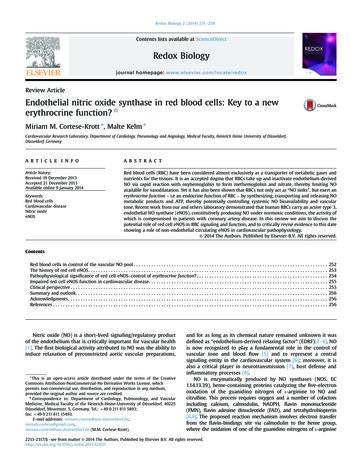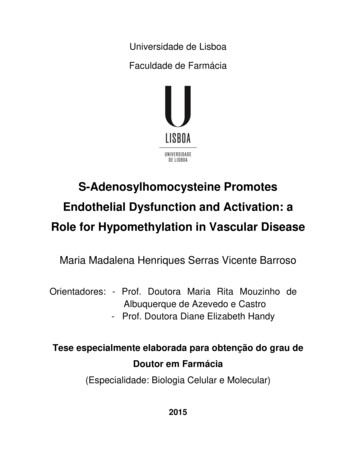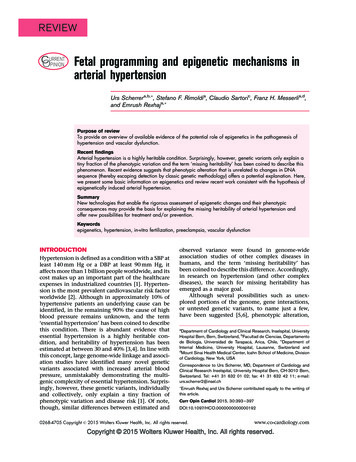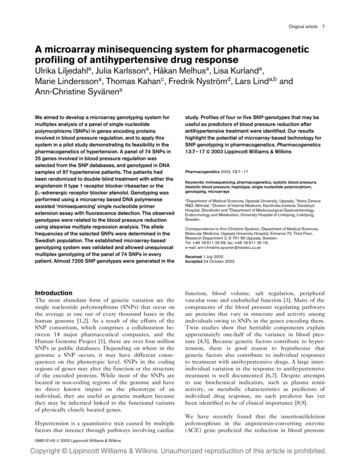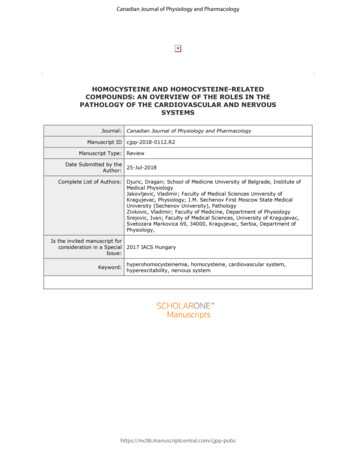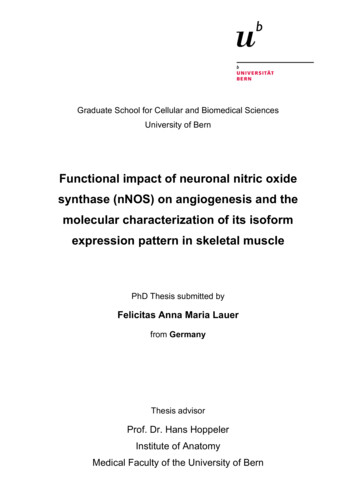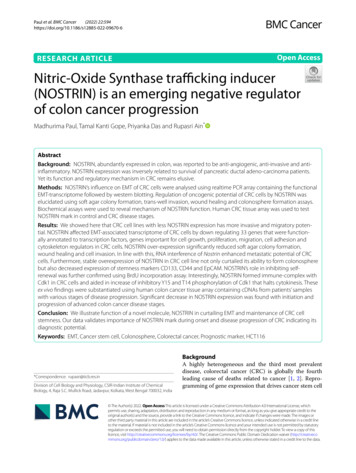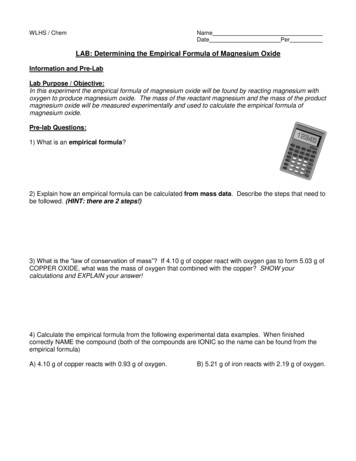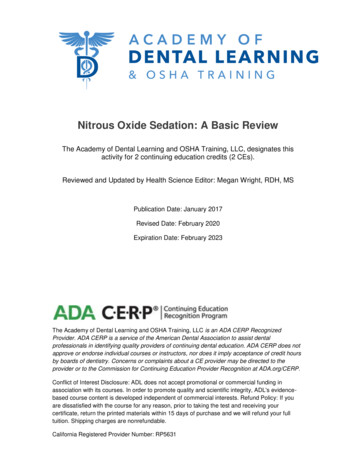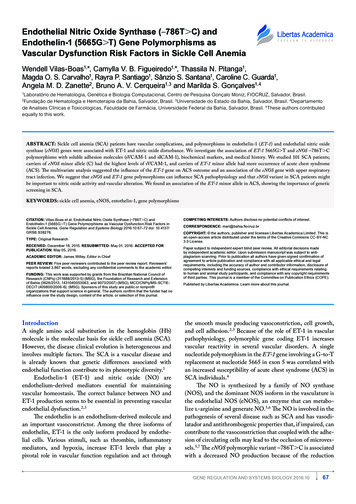
Transcription
Endothelial Nitric Oxide Synthase ( 786T.C) andEndothelin-1 (5665G.T) Gene Polymorphisms asVascular Dysfunction Risk Factors in Sickle Cell AnemiaWendell Vilas-Boas1,*, Camylla V. B. Figueiredo1,*, Thassila N. Pitanga1,Magda O. S. Carvalho1, Rayra P. Santiago1, Sânzio S. Santana1, Caroline C. Guarda1,Angela M. D. Zanette2, Bruno A. V. Cerqueira1,3 and Marilda S. Gonçalves1,41Laboratório de Hematologia, Genética e Biologia Computacional, Centro de Pesquisa Gonçalo Moniz, FIOCRUZ, Salvador, Brasil.Fundação de Hematologia e Hemoterapia da Bahia, Salvador, Brasil. 3Universidade do Estado da Bahia, Salvador, Brasil. 4Departamentode Analises Clínicas e Toxicologicas, Faculdade de Farmácia, Universidade Federal da Bahia, Salvador, Brasil. *These authors contributedequally to this work.2Abstract: Sickle cell anemia (SCA) patients have vascular complications, and polymorphisms in endothelin-1 (ET-1) and endothelial nitric oxidesynthase (eNOS) genes were associated with ET-1 and nitric oxide disturbance. We investigate the association of ET-1 5665G.T and eNOS 786T.Cpolymorphisms with soluble adhesion molecules (sVCAM-1 and sICAM-1), biochemical markers, and medical history. We studied 101 SCA patients;carriers of eNOS minor allele (C) had the highest levels of sVCAM-1, and carriers of ET-1 minor allele had more occurrence of acute chest syndrome(ACS). The multivariate analysis suggested the influence of the ET-1 gene on ACS outcome and an association of the eNOS gene with upper respiratorytract infection. We suggest that eNOS and ET-1 gene polymorphisms can influence SCA pathophysiology and that eNOS variant in SCA patients mightbe important to nitric oxide activity and vascular alteration. We found an association of the ET-1 minor allele in ACS, showing the importance of geneticscreening in SCA.Keywords: sickle cell anemia, eNOS, entothelin-1, gene polymorphismsCitation: Vilas-Boas et al. Endothelial Nitric Oxide Synthase ( 786T C) andEndothelin-1 (5665G T) Gene Polymorphisms as Vascular Dysfunction Risk Factors inSickle Cell Anemia. Gene Regulation and Systems Biology 2016:10 67–72 doi: 10.4137/GRSB.S38276.TYPE: Original ResearchReceived: December 18, 2015. ReSubmitted: May 01, 2016. Accepted forpublication: May 05, 2016.Academic editor: James Willey, Editor in ChiefPeer Review: Five peer reviewers contributed to the peer review report. Reviewers’reports totaled 3,867 words, excluding any confidential comments to the academic editor.Funding: This work was supported by grants from the Brazilian National Council ofResearch (CNPq) (311888/2013-5) (MSG), the Foundation of Research and Extensionof Bahia (3626/2013, 1431040053063, and 9073/2007) (MSG), MCD/CNPq/MS-SCTIEDECIT (409800/2006-6), (MSG). Sponsors of this study are public or nonprofitorganizations that support science in general. The authors confirm that the funder had noinfluence over the study design, content of the article, or selection of this journal.IntroductionA single amino acid substitution in the hemoglobin (Hb)molecule is the molecular basis for sickle cell anemia (SCA).However, the disease clinical evolution is heterogeneous andinvolves multiple factors. The SCA is a vascular disease andis already known that genetic differences associated withendothelial function contribute to its phenotypic diversity.1Endothelin-1 (ET-1) and nitric oxide (NO) areendothelium-derived mediators essential for maintainingvascular homeostasis. The correct balance between NO andET-1 production seems to be essential in preventing vascularendothelial dysfunction.2,3The endothelin is an endothelium-derived molecule andan important vasoconstrictor. Among the three isoforms ofendothelin, ET-1 is the only isoform produced by endothelial cells. Various stimuli, such as thrombin, inflammatorymediators, and hypoxia, increase ET-1 levels that play apivotal role in vascular function regulation and act throughCompeting Interests: Authors disclose no potential conflicts of interest.Correspondence: mari@bahia.fiocruz.brCopyright: the authors, publisher and licensee Libertas Academica Limited. This isan open-access article distributed under the terms of the Creative Commons CC-BY-NC3.0 License. aper subject to independent expert blind peer review. All editorial decisions madePby independent academic editor. Upon submission manuscript was subject to antiplagiarism scanning. Prior to publication all authors have given signed confirmation ofagreement to article publication and compliance with all applicable ethical and legalrequirements, including the accuracy of author and contributor information, disclosure ofcompeting interests and funding sources, compliance with ethical requirements relatingto human and animal study participants, and compliance with any copyright requirementsof third parties. This journal is a member of the Committee on Publication Ethics (COPE). Published by Libertas Academica. Learn more about this journal.the smooth muscle producing vasoconstriction, cell growth,and cell adhesion.2,3 Because of the role of ET-1 in vascularpathophysiology, polymorphic gene coding ET-1 increasesvascular reactivity in several vascular disorders. A singlenucleotide polymorphism in the ET-1 gene involving a G-to-Treplacement at nucleotide 5665 in exon 5 was correlated withan increased susceptibility of acute chest syndrome (ACS) inSCA individuals.4The NO is synthesized by a family of NO synthase(NOS), and the dominant NOS isoform in the vasculature isthe endothelial NOS (eNOS), an enzyme that can metabolize l-arginine and generate NO.5,6 The NO is involved in thepathogenesis of several disease such as SCA and has vasodilatador and antithrombogenic properties that, if impaired, cancontribute to the vasoconstriction that coupled with the adhesion of circulating cells may lead to the occlusion of microvessels.5,7 The eNOS polymorphic variant 786T.C is associatedwith a decreased NO production because of the reductionGene Regulation and Systems Biology 2016:1067
Vilas-Boas et alin eNOS gene expression and consequently the moleculeactivity. This condition results in vasoconstriction, plateletaggregation, and thrombosis. 3,8 The reduced or impairedNO production may results in endothelial cell activation andupregulation of adhesion molecules. Thus, shedding of soluble adhesion molecules into blood plasma can serve as markers either of endothelial dysfunction or of inflammation, withendothelial activation, a clinical situation present in SCAindividuals.6,8,9 Recent studies have suggested the importanceof several SNPs, including the eNOS and ET-1 genes, as riskmarkers for stroke, leg ulceration, pulmonary hypertension,priapism, and osteonecrosis in sickle cell disease patients.10The aim of this study was to investigate the eNOS 786T.C (rs2070744) and ET-1 5665G.T (rs5370) genepolymorphisms in SCA individuals and controls associatingtheir presence with levels of soluble intercellular adhesion molecule 1 (sICAM-1) and soluble vascular cell adhesion molecule1 (sVCAM-1), biochemical markers, and medical history.MethodsSubjects. We studied 101 SCA patients (mean age15.6 12.11 years) from Northeast Brazil attending the outpatient clinic of the Fundação de Hematologia e Hemoterapiada Bahia. All SCA patients were in the steady state of thedisease that was characterized as a time of three months without any acute clinical events and without using blood therapy4 months prior to blood sampling. The exclusion criteria werethe presence of infectious diseases, Hb profiles other thanSCA, and inflammatory episodes during the blood collection. Determination of eNOS polymorphism was possible in60 of these patients due to sample availability. One hundredeight healthy Brazilian subjects with normal Hb profiles wereincluded as a control group for ET-1 polymorphism, and81 subjects with normal Hb profiles were included as a controlgroup for eNOS polymorphism.This study was approved by the Centro de PesquisasGonçalo Moniz da Fundação Oswaldo Cruz’s ResearchBoard, and all patients and their guardians provided written informed consent, in accordance with the Declaration ofHelsinki of 1975 and its revisions. Clinical information wascollected from the patients’ records.Polymorphisms genotyping. The ET-1 5665G.T(rs5370) and eNOS 786T.C (rs2070744) gene polymorphisms were investigated by the polymerase chain reactionand restriction fragment length polymorphism techniques aspreviously described.8,11Soluble adhesion molecule measurements. Solubleadhesion molecules, sICAM-1and sVCAM-1, were estimatedusing the ELISA Kits (R&D Systems), according to themanu facturer’s recommendations.Biochemical and hematological analyses. Serumconcentrations of bilirubin, lactate dehydrogenase (LDH),aspartate aminotransferase, alanine aminotransferase(ALT), total cholesterol and fractions, triglyceride levels,68Gene Regulation and Systems Biology 2016:10and C-reactive protein (CRP) were determined using thecommercially available biochemical kits (LABTEST).Electronic cell counter (Coulter Corporation) was usedto quantify hematological parameters. Hb pattern and itsconcentration were estimated by high performance liquidchromatography (Bio-Rad).Statistical analysis. Baseline characteristics were summarized as proportions and mean of selected variables. TheKolmogorov–Smirnov test determines the distribution ofquantitative variables. Spearman’s rank correlation coefficientmeasures the strength of a linear relationship between paireddata. Nonparametric tests of Mann–Whitney and Kruskal–Wallis compare two or more groups of ET-1 and eNOS allelesand sVCAM-1 and sICAM-1 levels measured as quantitativevariables. The chi-square statistic test compares the tallies ofcategorical variables between two independent groups. Multivariate analyses were performed to show a possible interaction of ET-1 5665G.T gene polymorphisms, sVCAM-1,and LDH levels as risk factors on ACS outcome and of eNOS 786T.C gene polymorphisms, white blood cell, LDH, andCRP on infection outcome. Test analyses were significant ifP values were less than 0.05. Data analyses were conductedusing the software programs STATA 10 (StataCorp) andGraphPad Prism 5 (GraphPad Software).ResultsPolymorphisms frequencies. The ET-1 5665G.Tpolymorphism was analyzed in 101 SCA patients and 108healthy individuals, while the eNOS 786T.C was investigated in 60 SCA patients and 81 healthy controls. Our resultsshowed frequencies of 66.3% (67/101) for wild-type genotype(GG) and 33.6% (34/101) of heterozygous (GT) and 2.9%(3/101) of homozygous for the variant allele (TT) of ET-15665G.T gene polymorphism in SCA patients (Table 1). TheeNOS 786T.C gene polymorphism analysis showed 56.7%(34/60) for wild-type genotype (TT) and 36.7% (22/60) ofheterozygous (TC) and 6.5% (4/60) of homozygous for thevariant allele (CC) in SCA patients (Table 1). Both polymorphisms were in Hardy–Weinberg equilibrium. In the controlgroup, the frequency of ET-1 5665G.T gene polymorphismTable 1. Frequencies of ET-1 5665G.T and eNOS 786T.C genepolymorphisms among healthy individuals and SCA patients.Polymorphism Genotype FrequenciesFrequenciesHealthySCA patientsindividuals (%) (%)ET-1 5665G.TeNOS -786T.CGG60.2 (65/108)66.3 (67/101)GT32.4 (35/108)33.6 (34/101)TT7.4 (8/108)2.9 (3/101)TT54.3 (44/81)567 (34/60)TC42 (34/81)36.7 (22/60)CC3.7 (3/81)6.5 (4/60)
Vascular dysfunction risk factors in SCATable 2. Association of soluble adhesion molecules levels (sVCAM-1and sICAM-1) and ET-1 5665G.T and eNOS 786T.C genepolymorphisms.NMean ( SD)sVCAM-1 (ng/mL)sICAM-1 (ng/mL)32622.93 ( 393)425.71 ( 165)19574.09 ( 373)407.06 ( 131)0.8150.693ET-151Allele GAllele T*P valueeNOS38Allele T23420.39 ( 161)439.97 ( 193)Allele C15584.09 ( 238)411.61 ( 133)0.0280.906*P valueNote: *Mann–Whitney test.Abbreviations: sICAM-1, soluble intercellular adhesion molecule 1;sVCAM-1, soluble vascular cell adhesion molecule 1.was 60.2% (65/108) for wild-type genotype and 32.4%(35/108) of heterozygous and 7.4% (8/108) of homozygousfor variant allele (Table 1). The frequency of eNOS 786T.Cwas 54.3% (44/81) for wild-type genotype and 42% (34/81)of heterozygous and 3.7% (3/81) of homozygous for variantallele (Table 1).Adhesion molecules and polymorphisms. We associated gene polymorphisms with the serum levels of soluble adhesion molecules (sVCAM-1 and sICAM-1) andfound that patients’ carriers of the minor allele of eNOSgene polymorphism had the highest levels of sVCAM 1.Table 2 shows the genotypes of ET-1 and eNOS genepolymorphisms and mean of serum levels of the studiedsoluble adhesion molecules.Polymorphism and clinical data. Genotype frequencieswere compared between SCA patients with and without clinical events. Table 3 summarizes the association of clinical dataand the presence of polymorphisms in ET-1 and eNOS genes.When the allele frequencies were evaluated, we found an association of the ACS in patients’ carriers of the minor allele ofthe ET-1 5665G.T (P , 0.001) (Fig. 1).Biochemical data. Biochemical data were assessed inSCA patients. Analyses of the 51 SCA show that patients inpercentile 25% and 75% showed an association with the presence of the minor allele ET-1 5665G.T and levels of directbilirubin and total cholesterol. Patients carrying the minorallele T had higher direct bilirubin ( 0.4 mg/dL) (P 0.021,Fisher’s exact test) as well as a higher concentration of total cholesterol ( 169.7 mg/dL) (P 0.03, Fisher’s exact test). Patientscarrying the minor allele (T) had higher levels of direct bilirubin ( 0.4 mg/dL) (P 0.012, unpaired t test) (Fig. 2). Otherbiochemical data did not show differences with gene polymorphisms, including the eNOS gene polymorphism. However,sVCAM-1 was negatively correlated with total cholesterollevels (P 0.027, r 0.243) and ALT levels (P 0.005,r 0.307) (Fig. 3).Multivariate analysis. The multivariate analysis approachmodel investigates the interaction of the ET-1 5665G.T genepolymorphism, sVCAM-1, and LDH levels on ACS outcome(Table 4) and of the eNOS 786T.C gene polymorphism,white blood cell count, and LDH and CRP levels on upperrespiratory tract infection (Table 5).Table 3. ET-1 5665G.T and eNOS 786T.C gene polymorphisms association with clinical events among SCA patients.Clinical DataET-1eNOSGenotypeGGGenotypeGT and TTP valueGenotypeTTGenotypeTC and CC*P valueTransfusion14/217/210.5808/157/150.689Leg ulcers7/92/90.3021/54/50.188Acute chest syndrome3/85/80.1141/32/30.329Splenic sequestration1/32/30.2681/32/30.435Avascular ––Osteomyelitis2/20/20.4182/20/20.403Hand foot lelithiasis6/60/60.0542/31/30.801Aplastic crisis0/11/10.3461/10/10.650Notes: *Chi-square statistic test. **Fisher exact test.Abbreviations: ET-1, endothelin-1; eNOS, endothelial nitric oxide synthase.Gene Regulation and Systems Biology 2016:1069
Vilas-Boas et alP 0.001P 0.027r 0.243400ACS ACS 150Total cholesterolAllele number20010050300200100AlleleAlleleTG000Endothelin 5665G TDiscussion40This study shows a new interesting result regarding theassociation of eNOS 786T.C gene polymorphism andsVCAM-1 levels. SCA patient’s carrier of the minor allele(C) had higher sVCAM-1 levels, suggesting a contributionof this polymorphism on vascular inflammation. Based onthe information that eNOS polymorphic variant is related todecreased NO production because of the reduction in genepromoter activity,12,13 decreasing NO production in the minorallele carriers (C) is supposed to upregulate vascular adhesion molecules (as sVCAM-1) and the antiinflammatory roleof NO on vascular environment and, consequently, increasethe endothelial damage. It is known that NO inhibits plateletactivation and the expression of endothelial adhesion molecules, thus participating in healthy endothelial function andthe maintenance of blood flow.14,15These results suggest a role of these molecules on SCDmechanism. In addition to endothelial dysfunction, SCApatients have a decrease in vasodilator responses to NOdonors such as sodium nitroprusside and nitroglycerin,16,17molecules that promote vascular smooth muscle relaxation.Direct bilirubin (mg/dL)200015002000P 0.005r 0.30720005001000sVCAM-1Figure 3. Correlation between sVCAM-1, total cholesterol, and ALTamong 83 SCA patients.This phenomenon is related to vascular cell dysfunction andNO resistance where a portion of exogenous NO is scavengedby reactive oxygen species or free serum heme before it canstimulate vascular smooth muscle.18 The eNOS 786T.Cminor allele can be associated with an enhancement of theNO resistance state in the SCA individuals.3,8Also, in the current study, the ET-1 5665G.T minor allelewas associated with the occurrence of ACS in SCA patients,confirming previous results.4 The ACS is a combinationAllele GAllele T4Table 4. The multivariate model of the association of ET-1 5665G.Tgene polymorphism, sVCAM-1, and lactate dehydrogenase (LDH)levels in acute chest syndrome.Variable2ΒSETP valueET-1 5665G.T0.3510.1272.7720.011sVCAM-1 (ng/mL)0.0580.1220.4720.641ET-1 5665G.T0.3580.1262.8430.009sVCAM-1 (ng/mL)0.0570.1210.4670.645LDH (U/L)0.1650.1451.1360.268Model 1AlAlleleleleGT0ET-1 5665G TFigure 2. SCA patients carrying the minor allele (T) of the polymorphismET-1 5665G.T had higher levels of direct bilirubin ( 0.4 mg/dL)(P 0.012).701500ALT60P 0.0121000sVCAM-1Figure 1. Presence of ET-1 5665G.T alleles and occurrence of acutechest syndrome among SCA patients.6500Gene Regulation and Systems Biology 2016:10Model 2Abbreviations: B, coefficient; SE, standard error.
Vascular dysfunction risk factors in SCATable 5. The multivariable model of the association ofeNOS 786T.C gene polymorphism, white blood cell (WBC) count,lactate dehydrogenase (LDH), and C-reactive protein (CRP) levelson upper respiratory tract infection.VariableΒSETP valueeNOS -786T.C0.4200.1872.2490.037WBC ( 10 /L)0.3730.1901.9590.066eNOS -786T.C0.2680.1761.5170.149WBC ( 109/L)0.5020.1772.8380.012CRP (mg/L)0.3320.1821.8230.087LDH (U/L)0.4430.2092.1250.05Model 19Model 2Abbreviations: B, coefficient; SE, standard error.of radiographic evidence of new pulmonary infiltrates andrespiratory symptoms and is a frequent cause of hospitalization in SCA patients.19 Pathophysiology of events leading toACS progress in SCA was not determined but was consideredsimilar to those observed in other organ systems. The ACSlikely involves alterations of normal homeostatic functions ofvascular endothelium in the lungs.20 In addition to adherence,interaction of plasma factors and/or sickle red blood cells withendothelial cells may modify endothelial production of vasoactive mediators.2 The plasma ET-1 levels were clearly elevatedduring the initial period of ACS and decreased by the thirdday of hospitalization.21 This suggests a contribution of ET-1on ACS events probably by deregulating the mediators’ balance because of the presence of ET-1 5665G.T minor allele,once this gene polymorphism is related to abnormal vascularreactivity and ET-1 plasma levels.12,22 In the present study, wefound the association of the minor allele of ET-1 5665G.Twith ACS but not the homozygous state of the minor allele,and we emphasize that further study including a higher number of SCA patients is necessary to confirm the association ofthese genotypes as a high-risk of ACS among these patients.It was suggested that an imbalance between ET-1 andNO may contribute to changes in endothelial tone observedin the SCA, 3 and consequently, the presence of those polymorphisms can break such balance by abnormal expression or activity of these mediators contributing to thevascular impairment.In this study, we found negative significant correlationof sVCAM-1 and total cholesterol and ALT. Low total cholesterol levels were associated with the severity of hypertension and intracerebral hemorrhage, followed by the magneticresonance imaging changes23; also, a decrease in high-densitylipoprotein cholesterol, which may have influence on the totalcholesterol levels, has been related as an independent markerof endothelial activation, and also with an increase in inflammatory and oxidative stress molecules, such as sVCAM-1.24The negative correlation with ALT levels may suggest thatthe increase in sVCAM-1 in this studied SCA group was notassociated with hepatocellular damage.25Our results of multivariate analysis described a possibleinfluence of the ET-1 gene on ACS outcome and the association of eNOS gene with upper respiratory tract infection,showing a pivotal role of vascular mediators, like ET-1 andNO, in SCA pathophysiology, and also an interaction of theinvestigated gene with molecules and cells commonly involvedin the hemolytic and inflammatory processes. Further studieswill clarify the role of ET-1 and eNOS gene polymorphismsand will advance our understanding of the altered endothelialstate and clinical complications in SCA patients. It would beinteresting to show whether 786C minor allele has a reducedpromoter activity and eventually less eNOS transcription andwhether endothelial cells with 786C minor allele have lowerlevels of eNOS and eventually NO production.ConclusionWe suggest that eNOS 786T.C and ET-1 5665G.T genepolymorphisms may participate in the SCA pathophysiology.Our data show that eNOS variant in SCA patients might beimportant to NO activity and anti-inflammatory vascular process. Also, the ACS, a major clinical feature in SCA, whichleads to patient morbidity and mortality, was associated withthe ET-1 minor allele showing the importance of the screening of genetic biomarkers and their mechanisms.AcknowledgmentWe thank the patients for their participation because withoutthem, this study would not have been conducted.Author ContributionsCarried out the polymorphism typing and statistical analysis, participated in the study design, and drafted the article:WV-B. Carried out the polymorphism typing and participated in the study design: CVBF. Helped to draft the article:TNP, RPS, SSS, CCG. Helped in the sample collection andcontributed to the experimental work: MOS, AMDZ. Performed the biochemical and statistical analyses, participatedin the study design, and drafted the article: BAVC. Participated in the design and coordination of the study: MSG. Allauthors reviewed and approved the final article.References1. Hebbel RP, Osarogiagbon R, Kaul D. The endothelial biology of sickle cell disease:inflammation and a chronic vasculopathy. Microcirculation. 2004;11:129–51.2. Cardillo C, Kilcoyne CM, Cannon RO, Panza JA. Interactions between nitricoxide and endothelin in the regulation of vascular tone of human resistance vessels in vivo. Hypertension. 2000;35:1237–41.3. Alonso D, Radomski MW. The nitric oxide-endothelin-1 connection. Heart FailRev. 2003;8:107–15.4. Chaar V, Tarer V, Etienne-Julan M, Diara JP, Elion J, Romana M. Et-1 andecnos gene polymorphisms and susceptibility to acute chest syndrome and painful vaso-occlusive crises in children with sickle cell anemia. Haematologica.2006;91:1277–8.5. Romero JR, Suzuka SM, Nagel RL, Fabry ME. Arginine supplementation ofsickle transgenic mice reduces red cell density and gardos channel activity. Blood.2002;99:1103–8.Gene Regulation and Systems Biology 2016:1071
Vilas-Boas et al6. Vilas-Boas W, Cerqueira B, Pitanga T, et al. Sickle cell disease: only one road,but different pathways for inflammation. Adv Biosci Biotechnol. 2012;3:538–50.7. Kaul DK, Liu XD, Fabry ME, Nagel RL. Impaired nitric oxide-mediatedvasodilation in transgenic sickle mouse. Am J Physiol Heart Circ Physiol. 2000;278:H1799–806.8. Glueck CJ, Munjal J, Khan A, Umar M, Wang P. Endothelial nitric oxide synthase T-786c mutation, a reversible etiology of Prinzmetal’s angina pectoris. AmJ Cardiol. 2010;105:792–6.9. Kato GJ, Martyr S, Blackwelder WC, et al. Levels of soluble endotheliumderived adhesion molecules in patients with sickle cell disease are associatedwith pulmonary hypertension, organ dysfunction, and mortality. Br J Haematol.2005;130:943–53.10. Thakur TJ, Guindo A, Cullifer LR, et al. Endothelin-1 but not endothelial nitricoxide synthase gene polymorphism is associated with sickle cell disease in Africa.Gene Regul Syst Bio. 2014;8:119–26.11. Barden AE, Herbison CE, Beilin LJ, Michael CA, Walters BN, Van Bockxmeer FM.Association between the endothelin-1 gene Lys198 Asn polymorphism bloodpressure and plasma endothelin-1 levels in normal and pre-eclamptic pregnancy.J Hypertens. 2001;19:1775–82.12. Iglarz M, Benessiano J, Philip I, et al. Preproendothelin-1 gene polymorphism isrelated to a change in vascular reactivity in the human mammary artery in vitro.Hypertension. 2002;39:209–13.13. Sharan K, Surrey S, Ballas S, et al. Association of T-786c enos gene polymorphism with increased susceptibility to acute chest syndrome in females withsickle cell disease. Br J Haematol. 2004;124:240–3.14. Spiecker M, Darius H, Kaboth K, Hubner F, Liao JK. Differential regulation ofendothelial cell adhesion molecule expression by nitric oxide donors and anti oxidants. J Leukoc Biol. 1998;63:732–9.15. Villagra J, Shiva S, Hunter LA, Machado RF, Gladwin MT, Kato GJ. Platelet activation in patients with sickle disease, hemolysis-associated pulmonaryhypertension, and nitric oxide scavenging by cell-free hemoglobin. Blood.2007;110:2166–72.72Gene Regulation and Systems Biology 2016:1016. Reiter CD, Wang X, Tanus-Santos JE, et al. Cell-free hemoglobin limits nitricoxide bioavailability in sickle-cell disease. Nat Med. 2002;8:1383–9.17. Eberhardt RT, McMahon L, Duffy SJ, et al. Sickle cell anemia is associated withreduced nitric oxide bioactivity in peripheral conduit and resistance vessels. Am JHematol. 2003;74:104–11.18. Aslan M, Ryan TM, Adler B, et al. Oxygen radical inhibition of nitric oxidedependent vascular function in sickle cell disease. Proc Natl Acad Sci U S A.2001;98:15215–20.19. Vichinsky EP, Styles LA, Colangelo LH, Wright EC, Castro O, Nickerson B.Acute chest syndrome in sickle cell disease: clinical presentation and course.Cooperative study of sickle cell disease. Blood. 1997;89:1787–92.20. Paul RN, Castro OL, Aggarwal A, Oneal PA. Acute chest syndrome: sickle celldisease. Eur J Haematol. 2011;87:191–207.21. Hammerman SI, Kourembanas S, Conca TJ, Tucci M, Brauer M, Farber HW.Endothelin-1 production during the acute chest syndrome in sickle cell disease.Am J Respir Crit Care Med. 1997;156:280–5.22. Jin JJ, Nakura J, Wu Z, et al. Association of endothelin-1 gene variant withhypertension. Hypertension. 2003;41:163–7.23. Seung-Hoon L, Hee-Joon B, Byung-Woo Y, Ho K, Dong-Eog K, Jae-Kyu R.Low concentration of serum total cholesterol is associated with multifocal signalloss lesions on gradient-echo magnetic resonance imaging analysis of risk factorsfor multifocal signal loss lesions. Stroke. 2002;33:2845–9.24. Wan Ahmad WN, Farah S, Atiqah M, et al. Low serum high density lipoproteincholesterol concentration is an independent predictor for enhanced inflammationand endothelial activation. PLoS One. 2015;10:e0116867.25. Desai SP. Clinician’s Guide to Laboratory Medicine: A Practical Approach. Hudson,OH: Lexi-Comp; 2004.
We investigate the association of ET-1 5665G.T and eNOS 786T.C polymorphisms with soluble adhesion molecules (sVCAM-1 and sICAM-1), biochemical markers, and medical history. We studied 101 SCA patients; carriers of eNOS minor allele (C) had the highest levels of sVCAM-1, and carriers of ET-1 minor allele had more occurrence of acute chest .
